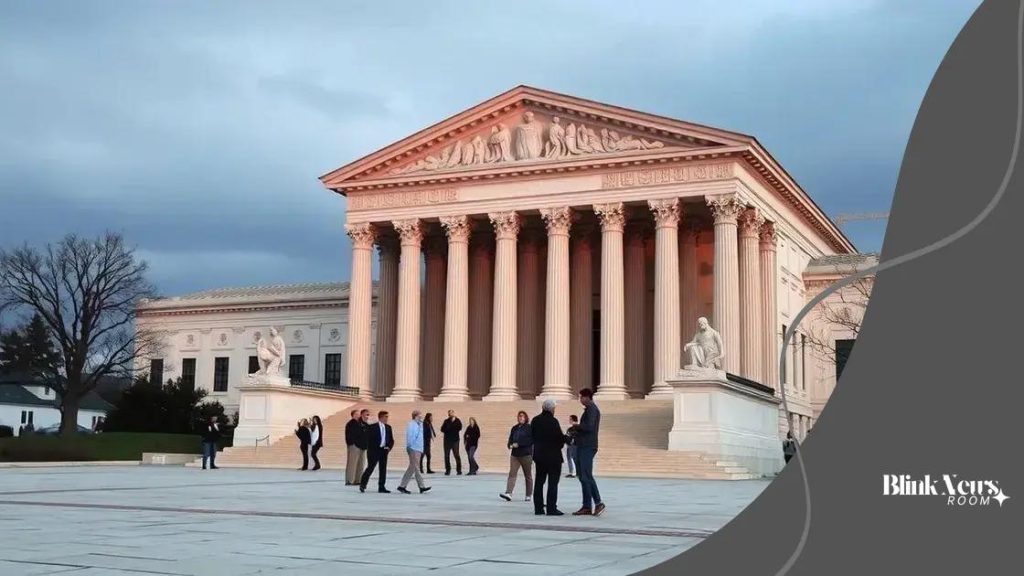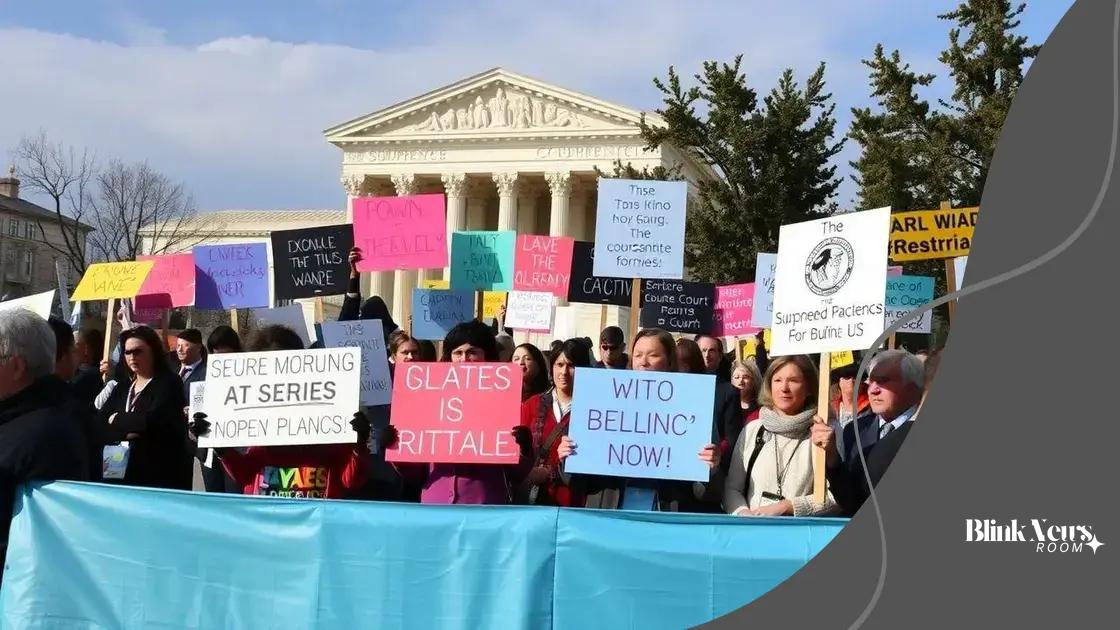Supreme Court decisions that shaped the nation

Anúncios
Supreme Court decisions significantly shape civil rights, daily life, and public policy in the U.S., influencing everything from healthcare access to voter rights and sparking social movements for change.
Supreme Court decisions play a crucial role in shaping the legal landscape of our country. Often surrounded by debate, these rulings affect various aspects of our daily lives—from civil rights to healthcare. What can we learn from these pivotal moments in legal history?
Anúncios
An overview of landmark Supreme Court decisions
Throughout U.S. history, landmark Supreme Court decisions have played a significant role in shaping the nation. These cases, often surrounded by intense public debate, address crucial issues that impact our rights and freedoms. Understanding their significance can provide insight into how the law evolves and adapts to societal changes.
Key Landmark Decisions
Many Supreme Court rulings stand out for their implications. Here are a few pivotal cases that transformed American law:
- Brown v. Board of Education (1954): This decision declared state laws establishing separate public schools for black and white students unconstitutional.
- Roe v. Wade (1973): A landmark case in which the Supreme Court recognized a woman’s right to choose to have an abortion under the right to privacy.
- Miranda v. Arizona (1966): This ruling established the requirement that individuals taken into police custody must be informed of their rights to an attorney and against self-incrimination.
These cases are more than just legal references; they reflect the ongoing struggle for equality and justice in American society. Each decision carries weight that resonates with personal stories and societal changes.
Anúncios
Additionally, decisions such as Obergefell v. Hodges (2015), which legalized same-sex marriage nationwide, highlight the Court’s role in advancing civil rights. The effects of these rulings often extend well beyond the courtroom, sparking conversations and movements across the country.
The Impact of Supreme Court Decisions
Each ruling can have lasting effects. For example, the Supreme Court’s interpretation of the Constitution can change societal norms and influence legislation. As these decisions unfold, they often lead to broader discussions about human rights and the role of government.
- They set precedents that guide future cases.
- They influence public opinion and activism.
- They can prompt legislative changes and new laws.
As society advances, new challenges arise, prompting the Supreme Court to revisit previous rulings. These decisions are central to the ongoing dialogue about rights and liberties in the United States.
Understanding the timeline and context of these landmark decisions not only informs readers about historical events but also engages them in the current discourse surrounding rights and justice.
The impact of Supreme Court rulings on civil rights
The impact of Supreme Court rulings on civil rights is profound and far-reaching. Many decisions have played a critical role in shaping the laws that protect the rights of all individuals in America. From race to gender, these rulings represent milestones in the ongoing fight for equality.
Key Supreme Court Cases
Important cases have altered the landscape of civil rights. A few notable rulings include:
- Loving v. Virginia (1967): This decision struck down laws banning interracial marriage, affirming the principle that marriage is a basic civil right.
- Griswold v. Connecticut (1965): The ruling established the right to privacy in marital relationships, paving the way for future cases involving reproductive rights.
- United States v. Nixon (1974): This case reinforced the principle that no one is above the law, even the President, promoting accountability and transparency.
Each of these decisions has contributed to the expansion of rights for various groups, highlighting the vital role of the Supreme Court in promoting justice.
Moreover, rulings like Title IX (1972) have fostered gender equality in educational institutions, prohibiting discrimination based on sex. Such laws not only protect rights but encourage societal shifts towards inclusivity.
Long-Term Effects
These rulings have lasting implications, affecting legislation and influencing public opinion. For instance, the ripple effect of decisions can spur movements and motivate citizens to advocate for their rights. Supreme Court decisions often serve as catalysts for change, prompting calls for legislative reforms.
- They inspire grassroots activism.
- They shape discussions about equality and rights.
- They provoke responses from various social and political groups.
The dialogue around civil rights continues to evolve, reflecting changing societal values. As new cases arise, the Supreme Court remains pivotal in addressing contemporary civil rights challenges.
Controversial Supreme Court decisions and public opinion

Controversial Supreme Court decisions often spark intense public debate and can shape societal views on important issues. These rulings may divide opinions and ignite protests, reflecting the passions of the American people.
Notable Controversial Cases
Throughout history, several Supreme Court decisions have generated significant controversy:
- Citizens United v. FEC (2010): This ruling allowed unlimited spending by corporations and unions in elections, raising questions about the impact of money in politics.
- Bush v. Gore (2000): The decision effectively resolved the 2000 presidential election, leading to mixed reactions regarding the fairness of the election process.
- Shelby County v. Holder (2013): This case invalidated key provisions of the Voting Rights Act, prompting fears about potential voter suppression.
Each case demonstrates how the Supreme Court can influence public sentiment and policy. Rulings can challenge established norms and provoke advocacy from various groups, amplifying voices both for and against these decisions.
Public opinion surrounding these cases often leads to protests and movements. For example, after Roe v. Wade (1973), opinions about abortion rights became deeply polarized, still impacting discussions today. Similarly, cases like Obergefell v. Hodges (2015), which legalized same-sex marriage, effectively mobilized supporters and opponents, altering social climates across the nation.
The Role of Media in Shaping Opinions
The media plays a critical role in how controversial Supreme Court decisions are perceived. Coverage can sway public opinion, either reinforcing views or sparking new debates. As social media platforms grow, discussions around these rulings have become even more dynamic, allowing for immediate reactions and interactions.
- Media bias can influence public perspectives.
- Social media amplifies grassroots activism.
- Public campaigns may arise in response to rulings.
Overall, the interplay between controversial Supreme Court decisions and public opinion reveals a complex relationship that continues to evolve. These decisions are not just legal matters but also reflect the values and beliefs of the society.
How Supreme Court decisions affect everyday life
The decisions made by the Supreme Court significantly impact everyday life in the United States. These rulings help shape the laws and rights that govern how individuals interact with one another and with government institutions.
Influence on Daily Rights
Supreme Court decisions can determine what rights citizens have in various situations. For example, rulings in cases like Miranda v. Arizona ensure that people are aware of their rights during police encounters, affecting how individuals experience law enforcement.
- Privacy rights: Decisions such as Roe v. Wade (1973) have established critical privacy rights, influencing access to healthcare and family planning.
- Voting rights: Other rulings have impacted access to the ballot box, such as Shelby County v. Holder, which altered voting laws that can lead to voter suppression.
- Civil rights: Landmark cases related to racial and gender equality create an environment that promotes fairness in workplaces and schools.
These rulings do not just affect the legal landscape but also help to define societal norms. For instance, the legalization of same-sex marriage through Obergefell v. Hodges has changed how families are recognized in society.
The Ripple Effect of Decisions
The effects of Supreme Court decisions reach far beyond the court itself. They often lead to changes in public policy and may influence future legislation. When the Supreme Court rules on a controversial issue, it can ignite public debate, leading citizens to advocate for changes in local and federal laws.
- Major decisions can mobilize advocacy groups.
- They can inspire citizens to participate in civic activities, like voting or lobbying.
- Social movements may arise to challenge or support the implications of these rulings.
Additionally, the media plays a significant role, shaping how these decisions are perceived by the public. Coverage of court cases can either fuel conversations around these issues or downplay their importance, influencing how people engage with their rights.
Future implications of recent Supreme Court rulings
The future implications of recent Supreme Court rulings are vital to understanding how societal norms and legal standards evolve. These decisions pave the way for potential changes in laws and public policy that can affect all citizens.
Anticipated Changes in Legal Landscape
Recent rulings often set precedents that shape how future cases are decided. For instance, rulings related to First Amendment rights have sparked dialogue about the balance between free speech and regulation. This can lead to significant shifts in areas such as:
- Digital privacy: With growing concerns about surveillance and data privacy, future rulings may further define the rights of individuals online.
- Reproductive rights: Decisions surrounding reproductive health could lead to a reevaluation of state laws and regulations, dramatically affecting access to services.
- Voting rights: Changes in how voting is regulated may be influenced by earlier decisions, potentially impacting voter access and election integrity.
These evolving legal landscapes can have far-reaching consequences for individuals and communities across the nation.
Societal Reaction and Activism
As these rulings unfold, society responds through activism and advocacy. New movements may emerge, addressing the implications of recent court decisions. For example, the reaction to rulings on healthcare access could reignite campaigns for universal coverage or improvements to existing systems. Citizens may mobilize to push for legislative changes that reflect the values established in Supreme Court decisions.
- Grassroots organizations may focus on mobilizing voters.
- Advocacy groups could work to educate the public on their rights and options.
- Legal challenges may arise to test the boundaries of new interpretations.
Understanding how current rulings may shape future actions remains crucial for sustaining democratic engagement and accountability. The dynamic relationship between court decisions and public response can lead to multi-faceted discussions on rights and governance.
FAQ – Frequently Asked Questions about Supreme Court Decisions
How do Supreme Court rulings affect my daily life?
Supreme Court rulings play a crucial role in shaping the laws that govern your rights, affecting everything from healthcare to voting.
What are some examples of landmark Supreme Court cases?
Examples include Roe v. Wade, which addressed reproductive rights, and Brown v. Board of Education, which tackled school segregation.
How do recent Supreme Court decisions influence public policy?
Recent decisions can lead to changes in laws, prompting legislators to respond with new legislation that reflects the court’s interpretations.
What can citizens do to influence Supreme Court-related issues?
Citizens can stay informed, engage in discussions, and advocate for their rights through social movements and by voting in elections.